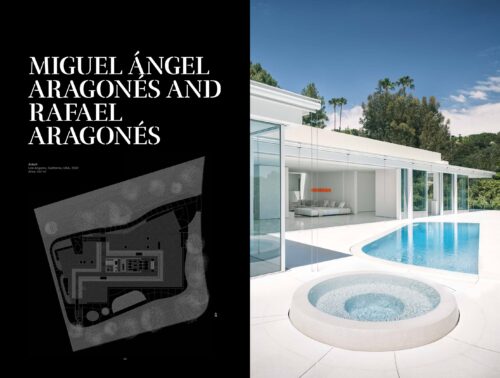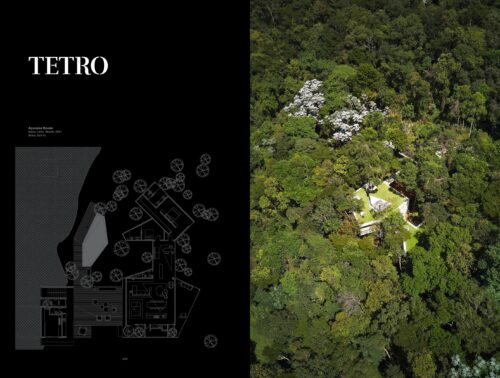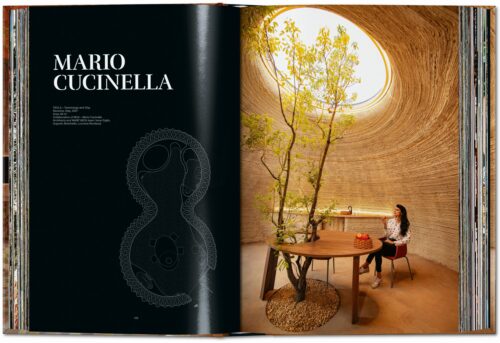»Homes for Our Time 3 — Contemporary Houses Around the World« is an inspiring collection of extraordinary living spaces that brings together innovative architecture, diversity and complexity of modern living culture in a large-format illustrated book. Published by TASCHEN Verlag.
The third volume in the series »Homes for Our Time« presents 59 contemporary projects in 25 countries, from the USA to Japan, accompanied by immersive photographs that provide an emotional level of spatial experience and illustrate different styles, from minimalist and functional approaches to opulent architecture and artistic interior design. What remains striking, however, is that despite unique concepts and creative approaches to (spatial) design, ultimately almost always uses nature as a timeless model.
Regardless of the technological level of implementation—when it comes to creating harmonious living spaces, it seems that architects and designers are guided by three central, nature-loving approaches. One of these is the seamless transition and connection between the interior and the landscape, i.e. houses that open up to nature. Definitely not a new idea, but one that has stood the test of time. If you look to Los Angeles, exceptional architects such as Richard Neutra promoted design ideas from the mid-20th century onwards that not only enabled a deeper connection to nature, but were also intended to bring a sense of space and freedom into living spaces.
This long tradition also includes a contemporary residential example, which can be found on the very first pages of »Homes for Our Time 3«: The Arkell project (Beverly Hills, Los Angeles, 2022) by Miguel Ángel Aragonés and Rafael Aragonés. Built on a gently sloping hillside, the house opens up to the outside with its open-plan design and generous window fronts, providing a view of the breathtaking, famous surrounding landscape, with the main roof greened with an extensive roof garden.


Unlike his mid-century role models, however, the possibilities of modern lighting concepts play a key role here alongside natural light—the trademark of the Aragonés father-and-son duo. The highlighting and influencing of (spatial) perception in architecture through innovative lighting technologies and direction has rarely been implemented so consistently and forcefully in buildings that serve as living spaces. In the intimate setting of one’s own home, the colorful, targeted lighting transforms supposedly everyday places into transformative and meditative spaces of experience.
The desire to create sustainable and inspiring living spaces that are not merely in connection with nature, but in deep harmony with it, goes one step further. »The starting point was the realization that architecture should adapt to the terrain and not the other way around«, according to the architecture studio Tetro—founded in 2008 by Carlos Maia, Débpra Mendes and Igor Macedo—quoted in the book and presented with their project Açucena House (Nova Lima, Brazil, 2021).


The unusual shape of the house, which is located in the Atlantic rainforest, the second largest tropical forest in Brazil, is partly due to the conscious effort to preserve the local nature, for example by not cutting down any trees during construction. Thin black support columns visually blend seamlessly into the forest area. Their main purpose is to lift the house off the ground and thus minimize the impact on the ecosystem.
Modern architecture that creates sustainable and unprecedented living spaces using highly developed technological possibilities can almost be seen as a mission. These are then no longer merely in connection or harmonious harmony, but in close partnership with nature. An outstanding example of this is the research project TECLA — Technology and Clay (Ravenna, Italy, 2021) by Mario Cucinella presented in the book.


According to Cucinella’s accompanying text, it is the first ecologically sustainable house to be printed in 3D from raw earth — a mixture of local soil, water and natural fibers from rice. As spartan as the prototype may seem at first glance, the demands on the technical possibilities are seemingly proportional to the desire and longing to be close to nature. Thanks to state-of-the-art printing techniques and materials, the building is virtually emission-free. And as if that wasn’t thought through enough, the shape of the architecture is based on typical local building styles— with the aim of maintaining structural balance.
»Homes for Our Time 3 — Contemporary Houses Around the World« is a study of contemporary living that reflects the desires of modern people. This includes not only, as one might think at first glance, the satisfaction of aesthetic sensibilities, but also, as volume 3 of the series clearly shows, the seemingly universal demand for peace and refuge that people have always sought and found through connection and access to nature. [DM]

Homes for Our Time. Contemporary Houses around the World. Vol. 3
Hardcover, 24.6 x 37.2 cm, 3.84 kg, 488 pages
taschen.com

